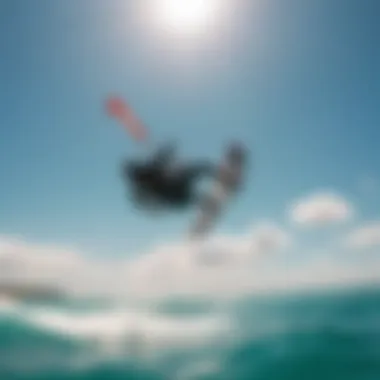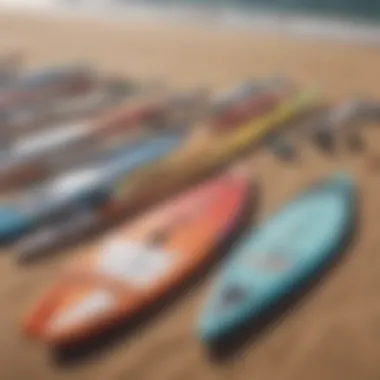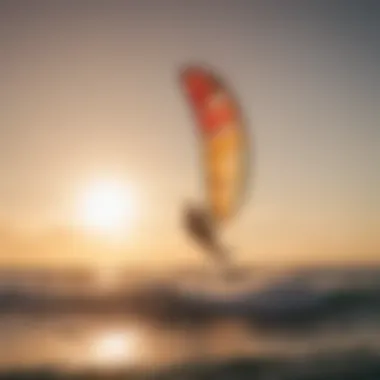Windsurfing vs Kitesurfing: A Detailed Comparison


Intro
Windsurfing and kitesurfing are more than just recreational activities; they are a lifestyle for many individuals who seek the thrill of gliding over water with the wind at their backs. The choice between these two sports can often lead to heated debates among enthusiasts. Each offers a unique blend of equipment, techniques, and cultural experiences. This article aims to untangle the threads connecting these two exhilarating sports, highlighting their distinctions, similarities, and relevance in today’s environment.
By exploring gear selection and skill development, this guide provides insights specifically designed for kiteboarders, instructors, and event organizers alike. The aim is to equip readers with solid knowledge that fosters responsible and informed participation in the ever-evolving world of wind-powered sports.
Gear Selection
Types of Kites
Choosing the right kite is essential for kitesurfing. Kites come in various shapes, sizes, and styles, each catering to different conditions and rider preferences. The most common types are:
- C-kites: Known for their power and performance, ideal for advanced riders who prioritize technical tricks.
- Delta kites: These offer great stability and easy relaunching, making them suitable for beginners and intermediate riders.
- Bow kites: Featuring a unique design that maximizes wind range, they are versatile and forgiving, excellent for freestyle riding.
Understanding wind conditions and one’s skill level is crucial when choosing the right kite. A kite that might work beautifully in light winds may not perform as expected during gusty conditions.
Choosing the Right Board
The board is just as important as the kite. Several styles of boards are available, with each suited for varying conditions and riding styles. Considerations include:
- Twin-tip boards: Symmetrical and easy to ride, perfect for beginners and those learning tricks.
- Directional boards: More commonly used in wave riding; they resemble surfboards and excel when facing downwind.
- Race boards: Designed for speed and competition, featuring a longer and narrower build.
Riders should seek boards that match their preferred riding style and skill level. A harmonious pairing of kite and board can significantly enhance the overall experience.
Skill Development
Essential Techniques
When it comes to mastering either sport, foundational skills are indispensable. For windsurfing, the importance of body positioning and balance cannot be overstated. Proper stance and weight distribution directly influence the ability to control the sail and board. In kitesurfing, mastering the "power zone" of the wind is crucial for harnessing lift and speed. The rider must learn to anticipate gusts and manage the kite's position in the sky.
Some key techniques to focus on include:
- Tacking and gybing (windsurfing): Skills that allow the rider to change direction efficiently.
- Water starts (kitesurfing): A pivotal skill enabling a rider to get up and ride after a fall.
Progression Tips
The path to improving in these sports involves plenty of practice and a willingness to tackle challenges head-on. Here are a few tips for progression:
- Set specific goals: Whether it’s landing a new trick or increasing your speed, having clear objectives helps maintain focus and motivation.
- Take lessons: Learning from experienced instructors can shorten the learning curve; consider local schools or workshops.
- Join a community: Connecting with fellow enthusiasts can provide support, tips, and camaraderie. Platforms like Reddit can be valuable resources for gaining experiences others have had.
With each session on the water, progress is bound to unfold, enriching the ride and deepening the appreciation for these dynamic sports.
"The ocean stirs the heart, inspires the imagination, and brings eternal joy to the soul."
By delving into gear selection and skill development, this comparative analysis aims to lay a solid foundation for understanding both windsurfing and kitesurfing. As we navigate through their histories and cultures, we will uncover the layers that make each sport unique, and inform responsible practices on the water.
Historical Context of Windsurfing and Kitesurfing
Understanding the historical context of windsurfing and kitesurfing is vital for grasping how these sports have evolved and shaped the board-riding culture we see today. It offers insights into the technological advancements, social dynamics, and environmental considerations tied to each discipline. By tracing their beginnings and developments, enthusiasts and novices alike can appreciate the layers of skill, creativity, and community that these sports foster.
Origins of Windsurfing
Windsurfing has its roots tracing back to the 1960s, when experimental designs like the "windsurfer" were first introduced by people yearning to merge surfing and sailing. A pivotal moment occurred in 1968 when a young American named Jim Drake, along with his friend Hoyle Schweitzer, created the first commercially successful windsurfing board. Their invention garnered attention rapidly, inspiring countless manufacturers to jump into the fray.
Much like a carpenter selecting the right tools, windsurfing requires thoughtful consideration of the equipment that defines the experience. The early boards were bulky and weighty, making them challenging to maneuver. Yet, the sheer thrill of harnessing wind and water drew enthusiasts into the sport. Events like the world championships in the late 70s and 80s initiated an unprecedented boom. In less than a decade, windsurfing transformed from a niche hobby into a mainstream sport, leaving an indelible mark on coastal culture.
Development of Kitesurfing
Kitesurfing, on the other hand, started to gain traction in the 1990s, a full two decades after windsurfing blossomed. While some claim the concept of using a kite to propel oneself over water dates back to the late 19th century, it wasn’t until the introduction of inflatable kites by innovators like Bruno Pottier and Cecile Tardy that kitesurfing truly flourished.
Through communal trials, thousands of eager riders on beaches began experimenting with kite size, shape, and control systems. Once kitesurfing hit the mainstream, it exacerbated a friendly rivalry between windsurfers and kitesurfers. Each community boasts unique styles and techniques, fostering a deeper camaraderie among participants. Kitesurfing's adaptability appeals to a diverse audience, altering landscapes from Caribbean shores to urban waterways.
Evolution of Techniques


Both sports evolved significantly in terms of techniques and styles. In windsurfing, maneuvers such as the "duck tack" and "back loop" emerged as distinct tricks, requiring practiced balance and body positioning. Similarly, kitesurfing enthusiasts began developing techniques focusing on performance, power, jumps, and finesse. Flips, spins, and bold aerial stunts define the thrill-seeking nature of the sport.
The progression of gear has also been a key factor in these developments. Lightweight materials, streamlined designs, and well-thought-out safety mechanisms have enhanced both sports. Kitesurfers, for instance, have gone from cumbersome kites to sleek designs that provide unmatched control. On the other hand, windsurfing equipment has transitioned into high-tech boards that allow for smooth sailing across diverse water conditions.
"Both windsurfing and kitesurfing embody the spirit of innovation and exploration. Understanding their history enriches our appreciation for the present state of these thrilling sports."
Technical Overview
The technical intricacies of windsurfing and kitesurfing are pivotal for understanding each sport’s dynamics and appeal. Technical elements involve not only the equipment but also the methods and performance metrics that define what makes these sports unique. Delving into these aspects allows enthusiasts, both novice and experienced, to make informed decisions about their practice and appreciate the craftsmanship behind each sport's apparatus. Evaluating techniques and equipment can also enhance safety and performance, ensuring practitioners enjoy the sports more while minimizing risks.
Understanding the Equipment
Windsurf Boards
Windsurf boards are the foundational element of windsurfing, serving as a platform where riders harness wind energy. The key characteristic of these boards is their buoyancy and design, catering to different conditions and rider abilities. A common choice among beginners is the wider, flatter boards, which provide stability and ease during learning.
One notable unique feature is the shape of the board, which can significantly impact how it glides on water. Boards can range from short and wide for stability to long and narrow for speed. More advanced windsurfers often opt for slalom boards that allow for high-speed transitions and races, albeit with decreased stability.
The advantages of a specialized windsurf board lie in performance enhancement, as each design suits specific conditions. However, a disadvantage arises for newcomers, who might feel overwhelmed by the variety of options available.
Kite Components
Kite components comprise the core of kitesurfing, facilitating the brilliant dances that kiteboarders execute on the water. The key characteristic of these components is their ability to harness the wind effectively, providing lift and steering control. The kite itself, along with elements like lines and the control bar, forms a cohesive unit that reacts to the wind and rider adjustments.
The unique feature of kite components is their modular design, allowing enthusiasts to swap out kites with different sizes or shapes depending on wind conditions and personal preference. This adaptability is a major advantage as it offers freedom and a customized experience. Conversely, the range of choices and varying qualities can confuse beginners, making the selection process daunting.
Techniques and Maneuvers
Windsurfing Techniques
Windsurfing techniques are characterized by the interplay between rider skill and environmental conditions. Mastering these techniques is crucial for both enjoyment and safety. A core characteristic of these maneuvers includes the ability to balance on the board while positioning the sail to catch the wind efficiently.
One unique feature of windsurfing techniques is their transition methods, which allow riders to change direction or speed. For example, the tack and jibe are fundamental moves that enhance control and speed. Understanding these techniques brings numerous advantages, such as increased agility and confidence on the water. However, the learning curve can be steep; improper technique might lead to frustration.
Kitesurfing Tricks
Kitesurfing tricks showcase the creativity and skill of the rider, blending performance with artistry. The key characteristic of kitesurfing tricks is their dynamic nature, relying heavily on the interaction between kite power and rider technique. Tricks often involve jumps, flips, and rotations, pushing the limits of mobility.
A unique feature of these tricks is their adaptability to various wind conditions and rider levels. Simple maneuvers like the kite loop can transition into more complex acrobatics as one's skills advance. The advantages of mastering these tricks not only include a surge in one’s enjoyment and confidence but also a sense of community through shared achievements and showcases. However, the potential for injury is an important consideration, emphasizing the need for adequate safety measures.
Performance Metrics
Speed Measurements
Measuring speed in windsurfing and kitesurfing is crucial for both competition and personal benchmarks. The key characteristic of speed measurements lies in their ability to quantify performance. Riders often yearn for higher speeds as this can enhance the thrill of the sport.
A unique feature of this aspect is the use of GPS devices to track speed, offering precise data over time and distances. The advantages of employing these tools are vast—riders can refine their strategies and adjust their techniques based on real-time feedback. However, reliance on technology might sometimes distract from the natural enjoyment of riding.
Jump Height Analysis
Jump height analysis provides insight into a rider’s skill progression and the effectiveness of their techniques. The key characteristic of this analysis focuses on how well a rider can harness the kite's lift against their body weight. High jumps are often seen as a pinnacle of skill in kitesurfing.
What sets this aspect apart is the combination of technique, timing, and wind conditions that contribute to achieving greater heights. The benefits include enhanced aerial techniques and improved overall performance. Yet, aspiring high jumpers must be cautious, as landing incorrectly can lead to significant injuries, underlining the importance of proper technique and safety.
"Understanding the technical elements of both windsurfing and kitesurfing enhances not only performance but also enjoyment and safety in the water. It's not just about the thrill; it's about mastering the art."
Engaging deeply with these components not only prepares practitioners for challenges but also enriches their overall experience in these exhilarating sports.
Comparative Analysis of Skills Required
When diving into the world of windsurfing and kitesurfing, one of the most crucial aspects to consider is the skills that each sport demands. Understanding the specific requirements not only helps enthusiasts choose the right sport for themselves but also enhances their overall experience on the water. Each sport offers a distinct set of skills that cater to varying levels of physicality and mental acuity, making it essential to assess what’s needed to thrive in these exhilarating activities.
Learning Curve


The learning curve in both windsurfing and kitesurfing can be quite steep, but it varies significantly between the two. Windsurfing tends to have a relatively more gradual introduction, allowing newcomers to become comfortable with balancing on the board while managing the sail. In contrast, kitesurfing poses an early challenge by requiring users to manage a powerful kite, which is demanding yet rewarding once mastered.
- For windsurfing:
- For kitesurfing:
- Mastering the sail and board can take a few sessions.
- Early stages focus on balance and proper stance.
- Initial lessons often include kite control, which can feel daunting at first.
- Riders must be attentive to wind conditions and learn to launch and land the kite safely.
In both cases, adequate instruction is paramount. A good instructor can smooth out the learning curve, guiding novices through the essential techniques. As such, a structured approach can be beneficial for anyone aiming to progress effectively.
Physical Demands
When talking about physical demands, windsurfing and kitesurfing place different kinds of stress on the body. Windsurfing involves a lot of upper body strength, particularly in the arms and core, as sailors need to pull the sail against the wind. Strength and endurance come into play here, especially during longer sessions where fatigue can affect performance significantly.
On the flip side, kitesurfing's physical demands are often more balanced across the body. The initial take-off requires strong leg muscles and core stability, modified with quick bursts of power to manage the kite. Once airborne, the focus shifts to balance and leg control during jumps and tricks, which might task the knee and thigh muscles differently than windsurfing.
- In summary, the demands break down as follows:
- Windsurfing involves:
- Kitesurfing necessitates:
- Strong upper body and core strength
- Balancing power versus wind direction
- Overall body strength
- Quick, powerful leg use for take-off and landings
Mental Aspects of Mastery
The mental components behind mastering either sport can't be overlooked. Both windsurfing and kitesurfing require acute awareness of environmental factors and personal skill levels. Riders must constantly adapt to changing wind patterns, water conditions, and equipment responsiveness.
Managing fear is another shared mental hurdle. Whether it's the fear of falling while trying to nail that perfect jump in kitesurfing or the apprehension of getting caught in tricky winds while windsurfing, both sports demand a strong mental fortitude.
- The considerations include:
- Focus on Safety: Being conscious of surroundings is critical.
- Development of Intuition: Recognizing wind shifts becomes second nature with experience.
Each area offers rich opportunities for personal growth and learning, allowing enthusiasts to enjoy the journey as much as the end goal of mastering the sport.
"In both sports, success doesn’t just come from strength or skill. It’s about understanding the dance with nature and embracing the mindset to adapt and overcome obstacles."
Through this comparative lens, enthusiasts may find clarity in selecting which sport aligns with their skills and personal preferences, ultimately leading to a more fulfilling experience.
Cultural Significance
The cultural significance of windsurfing and kitesurfing extends far beyond the thrill of gliding over water. These sports foster a sense of community, encourage environmental awareness, and energize local economies. Knowing their impact helps enthusiasts appreciate not just the sport itself but also how it weaves into the broader social fabric.
Community Building
Both windsurfing and kitesurfing create vibrant communities. Local clubs and schools often serve as hubs for interaction, where both novices and experienced riders share knowledge and advice. Engaging with others not only improves skills but also builds friendships. There’s a certain camaraderie that comes with sharing the learning journey, from battling those pesky early crashes to mastering tricky maneuvers.
The community can also be a powerful support system; many beginners find encouragement through local meet-ups or social media groups like those found on Facebook. Such platforms allow enthusiasts to discuss not just techniques but also gear recommendations and safety tips. The exchange of experiences fosters a culture that is inclusive, inviting everyone into the fold regardless of skill level. As people gather for events or casual sessions, the shared passion for the water becomes a bond that ties the community together.
Event Culture
Competitions
Competitions are a cornerstone of kitesurfing and windsurfing cultures. They attract a crowd and spotlight the sport's best talent. Beyond showcasing athletic skill, these events often serve as cultural celebrations, bringing together diverse groups from various locales. The split between national and international competitions offers something for everyone; they provide a platform for local riders to compete while also bringing in pros from around the globe.
A spirited atmosphere characterizes these competitions. Attending a windsurfing championship, for example, offers more than just thrilling contests; it’s often a festival filled with music, local food, and camaraderie among spectators. This vibrant setting fosters a sense of belonging, making the events a popular choice among both participants and attendees.
However, competitions can be double-edged swords. While they elevate the sport's profile and forge communities, they also create pressure for riders to perform. Some feel overwhelmed by comparison, potentially stifling their enjoyment of these exhilarating activities.
Riding Communities
The hallmark of riding communities is their inclusiveness and spirit of sharing. Whether in the bustling shores of Maui or the quieter beaches of Cape Town, kitesurfers and windsurfers often find common ground. Local riding communities provide resources such as advice on the best spots to catch wind and waves, tips for gear maintenance, and access to lessons from seasoned instructors.


What sets riding communities apart is their informal nature. It’s not just about the sport but about the joy of doing something together. Riding alongside fellow enthusiasts fosters a unique environment where learning happens organically. Each session can become a blend of fun and skill enhancement as beginners learn from more experienced riders and seasoned surfers give back to the newer generations.
Yet, riding communities are also not without their challenges. Sometimes, competition for the best spots can lead to conflicts. Even small disputes about waves or space can arise within these circles, occasionally marring the experience. Balancing the spirit of community with individual needs requires ongoing communication and respect among participants.
So, while competition and community engage sport enthusiasts differently, they both contribute significantly to the overall cultural significance of windsurfing and kitesurfing. Together, they create a rich tapestry where shared passion meets social bonding.
Environmental Considerations
In discussing the relationship between windsurfing, kiteboarding, and the environment, one must recognize the delicate balance between pursuing excitement on the water and preserving the natural world. Emphasizing environmental considerations is critical for enthusiasts, instructors, and event organizers alike, ensuring the long-term sustainability of both sports. By making educated choices about equipment and locations, participants can enjoy these thrilling activities while being mindful of their impact on nature.
Impact on Marine Life
Both windsurfing and kitesurfing, when practiced responsibly, can coexist with the marine ecosystem. However, it’s essential to acknowledge potential risks these activities can pose to local wildlife.
- Disturbance of Habitats: The high speeds and fast maneuvers of windsurfers and kiteboarders can lead to disruptions in sensitive marine areas. For instance, regions with nesting sea turtles or migratory fish populations require special attention. Avoiding such zones, especially during critical times, is crucial.
- Pollution Concerns: As thrilling as these sports are, equipment maintenance and usage can create waste—be it from old gear or used-up equipment. One has to consider proper waste disposal, to prevent pollution and minimize the harmful impact on local habitats.
- Ecosystem Balance: When choosing environments for these activities, enthusiasts should be aware of the ecological balance in place. Overcrowded spots can lead to increased wear on the sea floor, affecting sea grasses and corals that play essential roles in maintaining the ecosystem's health.
"The ocean's bounty is a treasure, but it must be cherished, not plundered."
Sustainability Practices
It's not all doom and gloom, though. The windsports community has been increasingly proactive about sustainability practices. Here are several actionable approaches to ensure the sport's footprint on the environment remains as light as a feather:
- Eco-Friendly Gear: Choosing environmentally sustainable products can make a difference. Companies like Naish or Duotone are focusing on materials with a lesser environmental impact. Opting for eco-friendly materials reduces reliance on non-biodegradable sources that can contribute to pollution.
- Education and Awareness: Community organizations can facilitate workshops to educate participants about their impact on marine environments. Understanding the principles of Leave No Trace can guide enthusiasts in making thoughtful decisions while they’re out on the water.
- Clean-Up Initiatives: Many groups and communities hold beach clean-ups and similar initiatives, gathering kiteboarders and windsurfers to clean waste from popular locations. Collaboration promotes responsibility and unity while positively impacting the environment.
- Selecting Sustainable Locations: Choosing the right spots for riding involves considering the area's ecological health. Checking local regulations helps enthusiasts avoid overpopulated waters, thus preserving the natural sanctity of the spots they love.
Through responsible practices, the windsurfing and kitesurfing communities have shown they can contribute positively to their environments. These efforts not only nurture marine life but also promote a sense of responsibility and stewardship among participants, ensuring that the exhilarating experiences of today remain for generations to come.
Safety Protocols
When diving into water sports like windsurfing and kitesurfing, safety protocols are not just optional suggestions; they are foundational requirements. Engaging in these activities poses inherent risks, such as unpredictable weather conditions, equipment failure, and physical exhaustion. Thus, understanding and implementing robust safety measures can greatly reduce accidents and enhance the overall experience. Not only can proper safety protocols help in avoiding injury, but they also create a more supportive and responsible atmosphere within the sports community.
"Safety isn't just a priority; it's a responsibility we carry as part of our water sports journey."
Essential Safety Gear
Every windsurfer and kitesurfer should be equipped with essential safety gear designed to protect them in a variety of situations. Below is a detailed overview of critical items that contribute significantly to safety:
- Life Jacket: A well-fitted personal flotation device (PFD) is non-negotiable. It keeps you afloat in case of a mishap and can buy you crucial time to recover.
- Helmet: Not just for paddleboarders, helmets are vital in preventing head injuries from sudden falls or collisions with equipment.
- Impact Vest: Similar to a life jacket but specifically designed to absorb shocks, which can be particularly useful for kitesurfers executing aerial tricks.
- Leash: Whether you’re on a board or a kite, a leash ensures equipment stays with you should you take an unexpected tumble.
- Sun Protection: High SPF sunscreen, a hat, and UV-protective clothing can protect your skin against harsh sun exposure, common during long sessions on the water.
Emergency Procedures
Even with the best safety measures, unforeseen incidents can occur, making it crucial to have emergency procedures in place. Here’s what you should consider:
- Know How to Signal for Help: Familiarize yourself and fellow riders with universal distress signals. A raised arm and waving can grab attention while floating on the water.
- Establish a Buddy System: Always have a partner who can watch your back. If something goes wrong, having someone nearby can be invaluable.
- Understand Current and Wind Conditions: Regularly check weather updates and understand how these natural elements affect your safety. If conditions deteriorate, have protocols to return to shore safely.
- First Aid Knowledge: Basic first aid training can come in handy, especially for dealing with bruises, cuts, or more serious injuries. Proper knowledge on how to manage injuries before professional help arrives is vital.
- Emergency Contact List: Have a list of emergency contacts handy. Your phone should include local emergency services, and let someone off the water know your plans and expected return time.
Implementing these safety protocols can empower windsurfers and kitesurfers, ensuring better experiences on the water. With safety as a priority, participants can freely enjoy all the thrill and excitement both sports have to offer.
Selecting the Right Environment
Choosing the right environment for windsurfing or kitesurfing is crucial, as it can significantly impact the overall experience and safety. It is not just about having a beautiful view or a fancy beach; certain conditions dictate how fun or challenging each session will be. Ideal spots will vary based on skills, equipment, and personal preference, which means understanding the local geography and weather patterns is fundamental. This section will delve into the specifics that both novice and experienced windsurfers and kiteboarders should consider when seeking the perfect location.
Ideal Locations for Windsurfing
When looking for prime windsurfing locations, several factors come into play. Here are key elements to consider:
- Wind Consistency: Steady winds are essential for an enjoyable experience. Most windsurfers prefer locations with winds ranging from 10 to 25 knots, which ensures smooth sailing without excessive struggle.
- Water Conditions: Flat water is usually favorable for beginners aiming to master their skills, while experienced riders might enjoy some chop or waves for more challenging conditions.
- Safety: Always pick spots with fewer obstacles like rocks and shallow areas. Familiarize yourself with local hazards to ensure safe enjoyment.
- Accessibility: Check if the location has easy access to parking, restrooms, and nearby accommodations, especially for longer trips.
Some noteworthy spots include:
- Lake Garda, Italy: Known for its predictable winds and stunning landscape, this location is a haven for both keen windsurfers and beginners.
- Hatteras Island, North Carolina: With its mixed conditions of flat water and waves, it's a popular choice among all skill levels.
- Tarifa, Spain: Famous for its strong winds, it’s a hotspot though sometimes can get crowded.
Best Kiteboarding Spots
Kiteboarding locations require a slightly different set of conditions. Here's what kiteboarders generally need to think:
- Wind Direction: Ideally, kiteboarders favor side or onshore winds. Offshore winds, while appealing, can prove dangerous due to potential drift away from the beach.
- Launch Areas: Large, open spaces without obstructions are necessary for safe launching and landing of kites. Look for spots that provide ample beach space.
- Tide Considerations: Certain spots may require specific tide levels for optimal conditions. Riders should check tidal schedules to avoid shallow waters.
- Local Culture: Some locations foster strong kiteboarding communities, which can enhance the experience by providing support and social opportunities.
Popular kiteboarding locations include:
- Cabarete, Dominican Republic: Known for its warm waters and consistent winds, perfect for riders looking to hone their skills.
- Maui, Hawaii: Offers stunning conditions and a vibrant kiteboarding scene, though it may be on the pricier side.
- Punta Cana, Dominican Republic: This spot features endless beach space and a friendly atmosphere, great for all levels.
"The right location can transform a good session into a great one; understanding the nuances can ensure you don’t end up outwitted by nature's whims."















